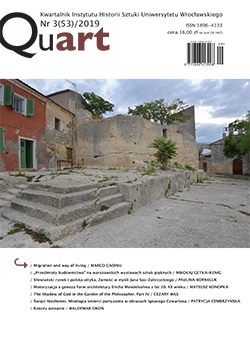 Numer 3(53)/2019
Numer 3(53)/2019
Editorial
In the autumn “Quartet” you will find a number of interesting articles, this time related to various forms of existence and functioning of diverse artworks in the period from the 12th century to the present. The first work by Marco Cadinu introduces us to a fascinating world of urban planning assumptions created in the Middle Ages in the Mediterranean basin as a result of the ambitions of extending the zones of influence of such mother-cities as Pisa, Siena, Genoa and Orvieto. The next text is a review of Warsaw’s exhibitions of fine arts from 1819–1828 in the hitherto little-recognised context of perceiving architecture as an object of interest and concern for the government policy of that period (Mikołaj Getka-Kenig). The discussion on our national characteristics and nativeness in art, which has been going on again for some time, is reflected in Paulina Korneluk’s work devoted to the views of one of the most interesting and controversial Polish architects and theoreticians of architecture from the turn of the 19th and 20th centuries, Jan Sas-Zubrzycki. For enthusiasts of motorization and architecture we have in “Quart” a dissertation with an intriguing title Car Genesis of Erich Mendelsohn’s Architectural Forms in the 1920s (Mateusz Konopka), and for those interested in postmodern theories – another episode of a theoretical series dedicated to the founding of Parc de La Villette and Bernard Tschumi (Cezary Wąs). The whole is crowned with two reviews: Patrycja Cembrzyńska’s, concerning the painting of Ignacy Czwartos, whose works we recently hosted at the Wrocław Contemporary Museum, and mine, devoted to the book written by Anna Markowska, which is a unique encyclopaedic and dictionary elaboration of the history of post-war art in Wrocław and the mysterious “handy things” connected with it.
It remains for me here to encourage you to lecture, proving once again that art has many names and that it is worth thinking about it in an unconventional and innovative way, which is evidenced by this latest issue of our quarterly recommended by me.
On behalf of the Editors
Prof. Dr. Hab. Waldemar Okoń
SPIS TREŚCI / TABLE OF CONTENTS:
![]() Spis treści / Table of Contents
Spis treści / Table of Contents
2
Od Redakcji
3
/Marco Cadinu/
![]() Migration and way of living. Houses, public spaces and city-planning in the late Middle Ages in the east-Mediterranean area
Migration and way of living. Houses, public spaces and city-planning in the late Middle Ages in the east-Mediterranean area
![]() Migration and way of living. Houses, public spaces and city-planning in the late Middle Ages in the east-Mediterranean area. Summary
Migration and way of living. Houses, public spaces and city-planning in the late Middle Ages in the east-Mediterranean area. Summary
22
/Mikołaj Getka-Kenig/
![]() „Przedmioty budownictwa” na warszawskich wystawach sztuk pięknych z lat 1819–1828 a problem modernizacji kultury architektonicznej w konstytucyjnym Królestwie Polskim.
„Przedmioty budownictwa” na warszawskich wystawach sztuk pięknych z lat 1819–1828 a problem modernizacji kultury architektonicznej w konstytucyjnym Królestwie Polskim.
![]() “Building objects” at Warsaw Fine Arts Exhibitions in 1819-1828 and the problem of the modernisation of architectural culture in the constitutional Kingdom of Poland. Summary
“Building objects” at Warsaw Fine Arts Exhibitions in 1819-1828 and the problem of the modernisation of architectural culture in the constitutional Kingdom of Poland. Summary
42
/Paulina Korneluk/
![]() Słowiański rynek i polska attyka – Zamość w myśli Jana Sas-Zubrzyckiego na podstawie artykułów jego autorstwa
Słowiański rynek i polska attyka – Zamość w myśli Jana Sas-Zubrzyckiego na podstawie artykułów jego autorstwa
![]() The Slavic market and the Polish attic – Zamość in the mind of Jan Sas-Zubrzycki on the basis of articles by him. Summary
The Slavic market and the Polish attic – Zamość in the mind of Jan Sas-Zubrzycki on the basis of articles by him. Summary
60
/Mateusz Konopka/
![]() Motoryzacja a geneza form architektury Ericha Mendelsohna z lat 20. XX wieku.
Motoryzacja a geneza form architektury Ericha Mendelsohna z lat 20. XX wieku.
![]() Motorisation and the genesis of Erich Mendelsohn’s architectural forms in the 1920s. Summary
Motorisation and the genesis of Erich Mendelsohn’s architectural forms in the 1920s. Summary
80
/Cezary Wąs/
![]() The Shadow of God in the Garden of the Philosopher. The Parc de La Villette in Paris in the context of philosophy of chôra. Part IV: Church / Church of Otherness
The Shadow of God in the Garden of the Philosopher. The Parc de La Villette in Paris in the context of philosophy of chôra. Part IV: Church / Church of Otherness
![]() The Shadow of God in the Garden of the Philosopher. The Parc de La Villette in Paris in the context of philosophy of chôra. Part IV. Summary
The Shadow of God in the Garden of the Philosopher. The Parc de La Villette in Paris in the context of philosophy of chôra. Part IV. Summary
114
/Patrycja Cembrzyńska/
![]() Święci Niezłomni. Mitologia śmierci partyzanta w obrazach Ignacego Czwartosa.
Święci Niezłomni. Mitologia śmierci partyzanta w obrazach Ignacego Czwartosa.
![]() Saints Unbroken. Mythology of the Death of a Partisan in Ignacy Czartos’s paintings. Summary
Saints Unbroken. Mythology of the Death of a Partisan in Ignacy Czartos’s paintings. Summary
137
/Waldemar Okoń/
![]() Rzeczy opisanie.
Rzeczy opisanie.
![]() Things description. Summary
Things description. Summary
Czasopismo indeksowane w Bazie Czasopism Humanistycznych
i Społecznych
BazHum.
Czasopismo indeksowane w CEJSH: The Central European Journal of Social Sciences and Humanities.
Czasopismo indeksowane w ERIH+: European Reference Index for the Humanities.
Czasopismo indeksowane w:
Index Copernicus International
World of Journals
Czasopismo ujęte w wykazie czasopism naukowych MEiN
z dnia 17.07.2023
(100 punktów).
Czasopismo nagrodzone grantem w ramach programu „Wsparcie 500 czasopism naukowych” Ministerstwa Nauki i Szkolnictwa Wyższego.
ISSN 1896-4133 (dla wydania drukowanego)
ISSN 2449-9285 (dla wydania elektronicznego)
www ® Aga Jarząb
apm@apmltd.com


